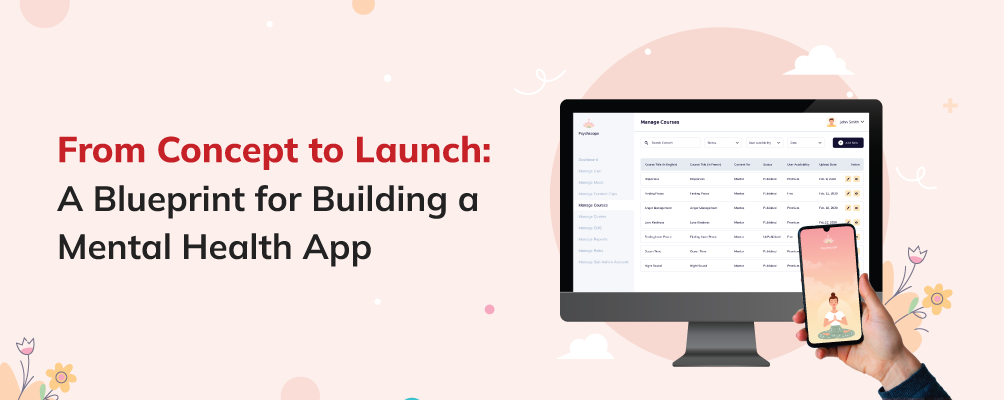
Mental health has been a growing concern globally, and technology has opened new doors to help individuals seeking treatment for mental health issues. With the increased usage of smartphones and the internet, developing a mental health app could provide much-needed support to individuals experiencing mental health issues, while providing mental health professionals an easily accessible platform to showcase their services and generate an additional revenue stream.
The rise of mental health apps is a reflection of the growing demand for convenient and accessible resources to address mental health concerns. Having an app that is dedicated to mental health can provide an invaluable platform not only for mental health experts but also for individuals who may benefit from mental health support in general. However, developing a mental health app is a bit of an intricate process which requires careful planning and execution.
There is a comprehensive blueprint outlined in the post that takes the reader through every step of the process of creating a mental health app from concept to launch.
Key steps involved in mental health app development are as follows:
Step 1: Defining the problem and target audience
The first step in building a mental health app is to define the problem it will solve and the target audience it will serve. Mental health concerns can vary widely, from anxiety and depression to PTSD and addiction. A mental health app can address one specific concern or offer a range of services to address multiple issues. Identifying the specific problem and audience will inform the app’s design, features, and marketing strategies.
Step 2: Conduct market research
Once the problem and audience have been identified, it is important to conduct market research to understand the competitive landscape and user preferences. This involves analyzing existing mental health apps and their features, as well as gathering user feedback through surveys or focus groups. This research will help identify gaps in the market and inform the app’s design and features.
Step 3: Identify the User's Requirements
Identifying the users’ requirements can help guide the development of mental health interventions and programs. This includes understanding the users’ needs, preferences, and constraints, as well as any potential barriers to accessing mental health services. By gathering this information, interventions can be tailored to meet the needs of the users.
Step 4: Conceptualization the Mental Health App
The first step in building a mental health app is to define the concept. Identify the problem the app will solve, the target audience, and the features the app will offer. Research and evaluate existing apps in the market and determine what features they offer and their impact on users. Also, consider the psychological needs of the users and identify what features can help them manage their mental health effectively.
Step 5: Assigning an App Development Team
Hire a team of developers, designers, and mental health professionals to bring the app concept to life. The development team should have expertise in app development, user experience design, and mental health treatment. Ensure that the team is familiar with the latest technological developments and trends in mental health treatment.
Step 6: Executing and Monitoring the App Development Process
Develop the app by creating a wireframe, designing the user interface, and building the app’s functionality. The app should be easy to use, visually appealing, and offer features that provide effective mental health treatment. Ensure that the app has a simple and user-friendly interface that is easy to navigate.
Step 7: Testing the App for Features and Functionality
Before launching the app, it’s essential to test it thoroughly to identify and fix any bugs and glitches. Testing helps ensure that the app functions correctly and provides an excellent user experience. Consider conducting user testing to gather feedback on the app’s usability and effectiveness in treating mental health issues.
Step 8: Launch the App
Once the app has been tested and all necessary adjustments have been made, it’s time to launch the app. Promote the app through various marketing channels, such as social media, app stores, and mental health communities. Consider partnering with mental health professionals and organizations to promote the app and reach a broader audience.
Step 9: Ensuring Regular Monitoring and Releasing Updates
After launching the app, it’s essential to monitor its usage and effectiveness continually. Collect user feedback and identify areas that require improvement. Regularly update the app to fix bugs and add new features that enhance the user’s experience and improve its effectiveness in treating mental health issues.
The mental health app development process involves designing, prototyping, coding, testing, and deployment of applications that aim to improve users’ mental health. This process typically involves a team of developers, designers, and mental health professionals who collaborate to create an application that is effective and user-friendly.
Conclusion
Developing a mental health app requires a comprehensive understanding of the target audience’s needs and an effective strategy to bring the app from concept to launch. From defining the problem and target audience to monitoring and updating the app, each step in the process is crucial to the app’s success.
Have a Mental Health App on Plan? Consider Nickelfox as Your Technology Partner.
If you are a mental health professional seeking to shift your mental health services to a digital platform, Nickelfox can assist you with an intuitive, secure, and accessible mental health app to market your mental health services to your prospects.
Nickelfox is an app development expert having specializations in mental health apps. Should you be looking for an app development company for your mental health app, Nickelfox may be worth considering as your technology partner.
No Comments